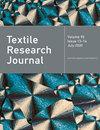通过焦耳效应监测分析确定纺织涂层中导电粒子分散的特性
IF 1.9
4区 工程技术
Q2 MATERIALS SCIENCE, TEXTILES
引用次数: 0
摘要
在印花浆或纺织涂层中实现颜料、染料或其他添加剂(如微胶囊或纳米颗粒)的适当分散,对于获得均匀的效果至关重要。在某些专业应用领域,例如着色技术,可以使用色度测量工具、目测甚至人工视觉来识别缺陷。然而,这些技术都无法全面反映特定添加剂的分布情况。本文提出了一种新方法:利用焦耳效应监测丙烯酸涂层浆料中导电颗粒(石墨烯纳米颗粒,简称 GNP)的分布。该研究采用了四种不同的分散系统(超声波混合器、搅拌器、环形搅拌器和三辊研磨机)。热成像图像可准确显示导电粒子的分布情况。这是对数值数据(如每个样品记录的最高和平均温度)的补充。在某些情况下,仅仅依靠数值是不够的,因此本文强调了利用焦耳效应评估导电粒子分布的重要性。关于混合系统,使用超声波混合器可最有效地实现 GNPs 在蒸馏水中的最佳分散,随着分散时间的延长,均匀度也会提高。在混合涂层浆料的各组分时,环形搅拌法的效果最好。由于三辊研磨机容易导致相分离,因此不建议在此应用中使用。本文章由计算机程序翻译,如有差异,请以英文原文为准。
Characterization of conductive particle dispersion in textile coatings through Joule’s effect monitoring analysis
Achieving proper dispersion of pigments, dyes, or other additives, such as microcapsules or nanoparticles, within printing pastes or textile coatings is crucial for obtaining a homogeneous result. In certain specialized applications, such as coloration technology, it is possible to use colorimetry tools, visual examination, and even artificial vision to identify defects. However, none of these techniques comprehensively map the specific additive distribution. This paper proposes a novel approach: monitoring the distribution of conductive particles (graphene nanoplatelets, referred to as GNPs) within an acrylic coating paste using the Joule’s effect. Four different dispersion systems (ultrasound mixer, blender, toroidal agitation, and three-roll mill) are employed. Thermographic images provide an accurate view of how conductive particles are distributed. This complements data from numerical values, such as the maximum and average temperatures recorded for each sample. In certain cases, relying solely on numerical values can be inadequate or insufficient, hence the novelty of this article emphasizing the significance of using the Joule’s effect to assess the distribution of conductive particles. Concerning the mixing systems, optimal dispersion of GNPs in distilled water is most effectively achieved using an ultrasound mixer, with enhanced uniformity as dispersion time increases. For mixing the components of the coating paste, the toroidal agitation method yields the best result. Employing the three-roll mill is discouraged for this application due to its propensity to induce phase separation.
求助全文
通过发布文献求助,成功后即可免费获取论文全文。
去求助
来源期刊

Textile Research Journal
工程技术-材料科学:纺织
CiteScore
4.00
自引率
21.70%
发文量
309
审稿时长
1.5 months
期刊介绍:
The Textile Research Journal is the leading peer reviewed Journal for textile research. It is devoted to the dissemination of fundamental, theoretical and applied scientific knowledge in materials, chemistry, manufacture and system sciences related to fibers, fibrous assemblies and textiles. The Journal serves authors and subscribers worldwide, and it is selective in accepting contributions on the basis of merit, novelty and originality.
 求助内容:
求助内容: 应助结果提醒方式:
应助结果提醒方式:


